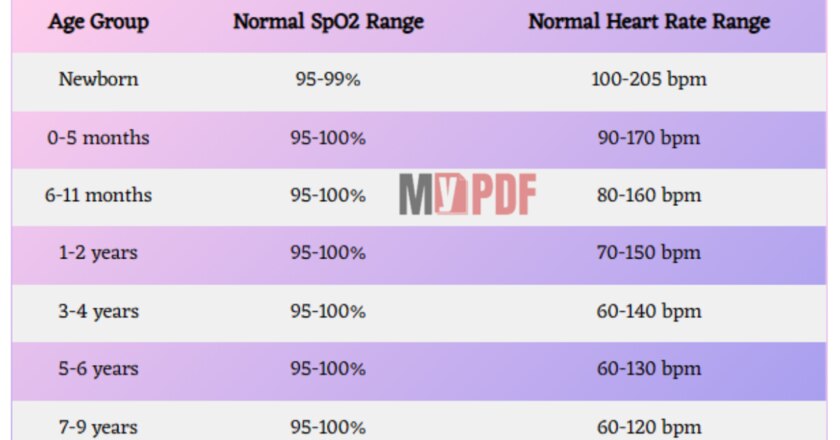Pulse Oximeter Readings Chart Pdf, Free Pulse Oximeter Chart Download, Pulse Oximeter Normal Range Chart PDF, Pulse Oximeter Tracking Sheet PDF, SpO2 Level Monitoring Chart PDF.
| PDF Name | Pulse Oximeter Readings Chart Pdf |
| No. of Pages | 24 |
| PDF Size | 982 kb |
| Language | English |
| PDF Category | Health & Fitness |
| Download Link | Available |
| Published/Updated | March 8, 2023 |
| Source / Credits | who |
| Uploaded By | MyPdf |
Pulse Oximeter Readings Chart Pdf
Here’s a chart that shows the normal range for heart rate and oxygen saturation (SpO2) levels by age group:
| Age Group | Normal SpO2 Range | Normal Heart Rate Range |
|---|---|---|
| Newborn | 95-99% | 100-205 bpm |
| 0-5 months | 95-100% | 90-170 bpm |
| 6-11 months | 95-100% | 80-160 bpm |
| 1-2 years | 95-100% | 70-150 bpm |
| 3-4 years | 95-100% | 60-140 bpm |
| 5-6 years | 95-100% | 60-130 bpm |
| 7-9 years | 95-100% | 60-120 bpm |
| 10-12 years | 95-100% | 50-120 bpm |
| 13-15 years | 95-100% | 50-110 bpm |
| 16 years | 95-100% | 50-100 bpm |
What is Pulse Oximeter?
A pulse oximeter is a medical device used to measure the oxygen saturation level in a person’s blood. It is a non-invasive tool that can be clipped onto a finger, toe, or earlobe and uses light to measure the level of oxygen in the blood.
The device works by emitting light wavelengths through the skin and measuring the amount of light that is absorbed by the blood. Oxygenated blood absorbs more light than deoxygenated blood, allowing the device to calculate the oxygen saturation level in the blood.
Pulse oximeters are commonly used in hospitals and healthcare settings to monitor the oxygen levels of patients with respiratory or cardiovascular conditions, as well as during surgery and anesthesia. They can also be used at home by individuals with conditions such as chronic obstructive pulmonary disease (COPD) or sleep apnea to monitor their oxygen levels and adjust their treatment as needed.
How to read Pulse Oximeter?
A pulse oximeter displays two key measurements: the oxygen saturation level (SpO2) and the pulse rate.
The oxygen saturation level is usually expressed as a percentage and indicates the amount of oxygen that is being carried by the hemoglobin in the blood. A normal oxygen saturation level is typically between 95-100%, while levels below 90% may indicate a problem with oxygenation and require medical attention.
The pulse rate, also known as the heart rate, is measured in beats per minute and indicates the number of times the heart beats per minute. A normal pulse rate is typically between 60-100 beats per minute, but it can vary depending on age, fitness level, and other factors.
To read a pulse oximeter, place the device on the finger, toe, or earlobe according to the manufacturer’s instructions. Wait a few seconds for the device to display the readings. The SpO2 level and pulse rate will be shown on the screen.
It’s important to note that pulse oximeters may not always be completely accurate, especially in people with certain medical conditions or in certain situations such as low blood pressure or cold extremities. If you have concerns about your oxygen saturation levels or pulse rate, it’s important to seek medical advice from a healthcare professional.
What is normal readings for Pulse Oximeter?
A normal reading for a pulse oximeter is typically an oxygen saturation (SpO2) level of 95% or higher. However, the normal range may vary depending on a person’s health, medical history, and other factors.
A healthy individual should also have a normal heart rate or pulse rate, which typically ranges between 60-100 beats per minute (bpm) at rest. However, the normal range for heart rate can vary depending on age, fitness level, and other factors.
It’s important to note that pulse oximeter readings can be affected by a variety of factors, such as cold fingers, nail polish, poor circulation, and certain medical conditions. If you have concerns about your pulse oximeter readings, it’s best to consult with a healthcare professional for further evaluation and advice.
Which finger to use for Pulse Oximeter?
Most pulse oximeters are designed to be placed on the index finger, but they can also be used on the middle finger or any other finger that fits comfortably in the device.
Most pulse oximeters are designed to be placed on the index finger, but they can also be used on the middle finger or any other finger that fits comfortably in the device.
It’s important to ensure that the finger is clean and dry before placing the pulse oximeter on it. If the finger is cold, it may be helpful to warm it up by rubbing it gently or placing it in warm water for a few minutes before taking the measurement, as this can improve blood flow and accuracy of the reading.
If you have poor circulation in your fingers or if you are unable to use your fingers for any reason, you may be able to use a different part of your body, such as your earlobe or toe, to take the measurement. However, it’s important to follow the instructions provided by the manufacturer and consult with a healthcare professional if you have any questions or concerns.
So, don’t delay and download the PDF from the link given below.
You can download the Pulse Oximeter Readings Chart Pdf Download the link given below:
Report This: We DO NOT own any copyrights of this PDF File. If you want this Pulse Oximeter Readings Chart Pdf Download to be removed or if it is copyright infringement, do drop us an email at email@mypdf.in and this will be taken down within 24 hours!
